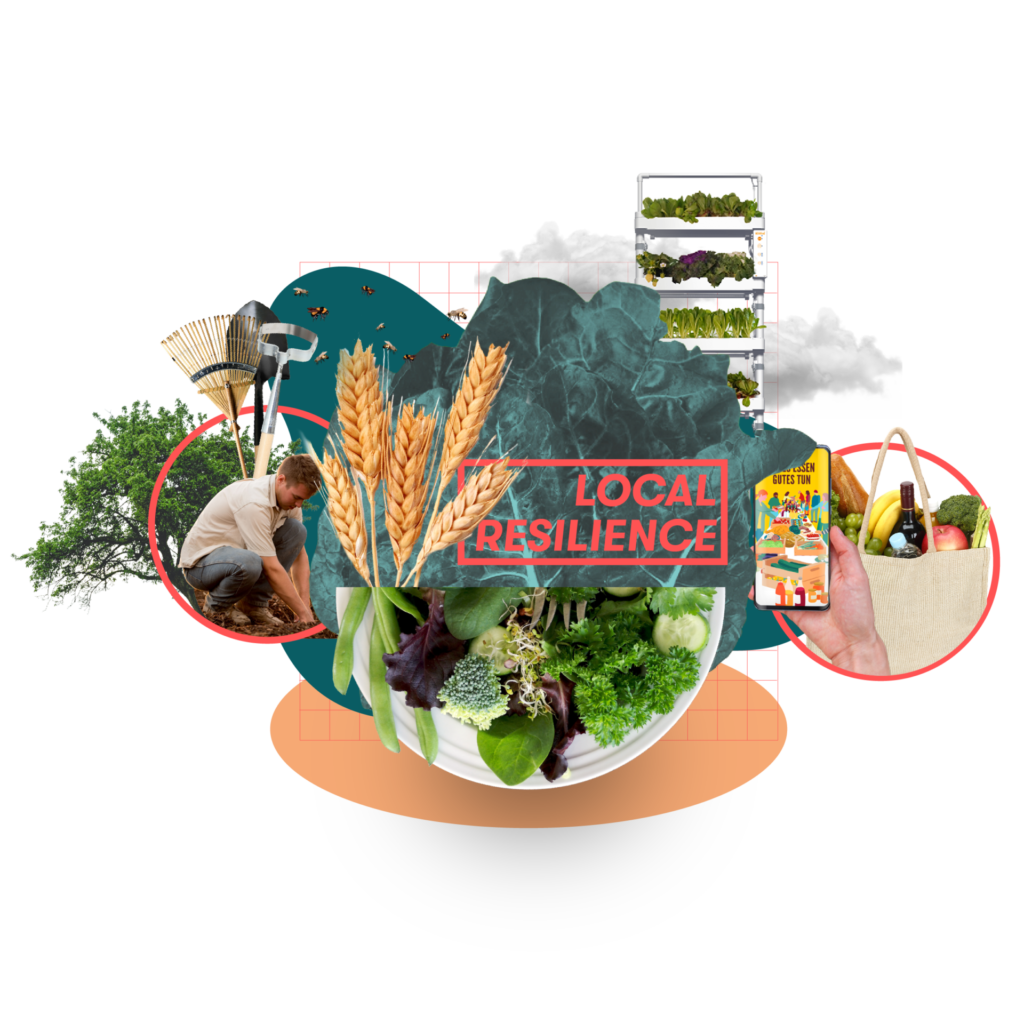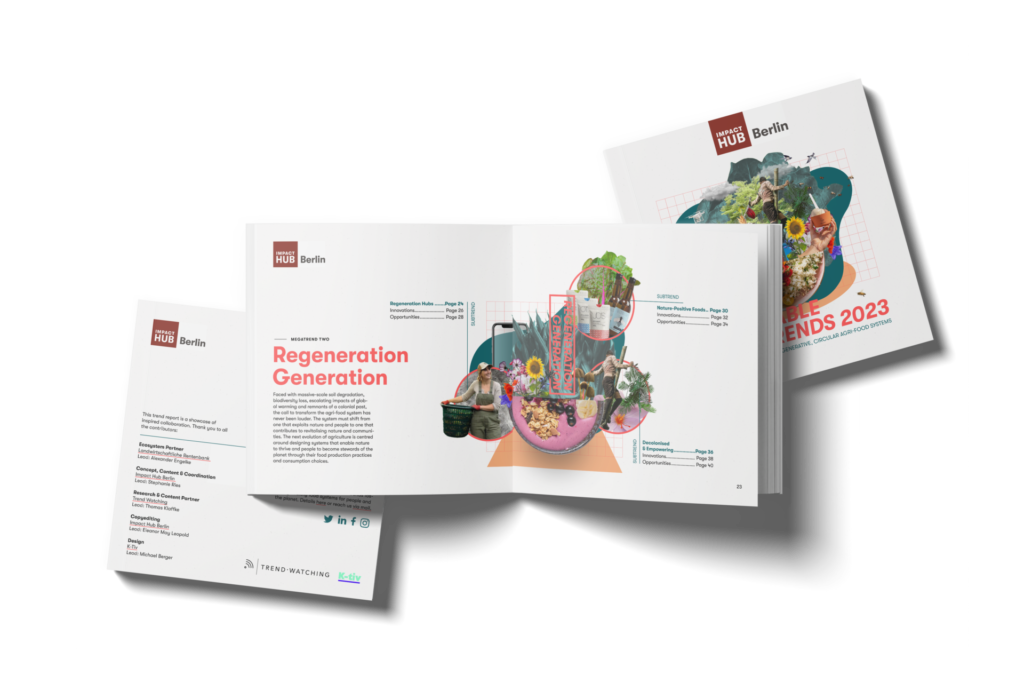What can food trends tell us about the future of food?
Trends drive transformation and radical change. They are the undercurrents sweeping our work at Impact Hub Berlin and changemakers around the globe towards the future.
But while we might not notice them day to day, we do have the tools to dive in and discover which direction global and local crisis, changes and needs are taking us and how we too can take the helm.
Trends create new realities and knowledge of those trends can enable us to shape those realities. This is as true for sustainable food, as it is for circular economy, green tech or diversity, equity and inclusion — the other ecosystems that Impact Hub Berlin is helping to shape with our partners and ventures.

Today’s food system
What do we do then? Can we replenish the soil? Do we need to find new means to grow our food?
In Germany, the food supply chain, fertiliser production, transport of goods, food retail and food preparation contributes 25% of the country’s total greenhouse gas emissions (as of 2018) . That places food production as the fifth highest contributor to GHG emissions, a close runner-up to energy, industry, transport and buildings. Fuelled by these heat-trapping gases, global temperatures are likely to surge to record temperatures in the next 5 years, according to the World Meteorological Organisation. These are not the kind of records we want to be breaking.
Don’t be fooled into thinking that a rise in temperatures could be a nice thing for us Northern Europe dwellers. Scientific projections show that the duration of severe and extreme soil drought events in Europe could increase by up to 246%.
But things are changing, the earth beneath our feet is (quite literally) shifting and there is hope on the horizon. We just need some help seeing through the heat haze.
Consumer needs and expectations
There is cause to be optimistic though. In Germany, 70% of people say they want to become ‘planetary stewards’ and actively protect and regenerate our planet’s natural resources. The problem is, it’s often very difficult to know how.
As consumers, we’re not always given the information we need in a way that is easy to digest or supported to make the right decisions. A huge “87% of Germans said they find it “very” or “rather difficult” to recognise which products adhere to high environmental standards” and which don’t, when they’re shopping for groceries.
Despite these barriers, more and more people are demanding that food producers, distributors and brands, as well as policy makers, take more social and environmental responsibility. It is clear that governments, communities, consumers and businesses need to work together to create the kind of change required to shift from our current reality to a future food system which replenishes, regenerates and empowers. Yet right now, only 27% of German citizens think the government has a clear plan for this.

Trends and innovation
The good news? Innovation doesn’t wait for political change.
Food trends are already moving the tide and innovators from across the world and the DACH region are taking hold of the opportunity with both hands. These innovators are answering the calls of people unsatisfied with an unsustainable food system and positioning themselves at the bow of food trends and trends in sustainability.
You too can make sure your organisation stays relevant and innovative in future sustainable food systems by paying attention to trends and grasping the opportunities for collective action that they present. Whether you’re an entrepreneur, intrapreneur or simply a food enthusiast, trends can help you create agrifood products, services and brand experiences today that will serve the food systems and consumers of tomorrow.
In fact, understanding food trends might be the only way you can stay ahead in today’s expectation economy in which the latest innovation from any industry or market can set the expectation for the whole economy. Want to set rather than meet consumer expectations? Then trends are your answer.
Trend methodology
But what actually are trends and how do you know which ones to pay attention to? Don’t worry – here, we’ve done the work for you.
In collaboration with Trendwatching, who bring over 20 years of experience in trend and innovation spotting, we combed through countless data sources to hunt down the intersections between consumer needs, macro-trends and innovations in agrifood and sustainable food. The result of these intersections are new consumer expectations and new trends in food sustainability.
Consumer needs remain relatively constant; for example, the need to access affordable and nutritious food. When these collide with macro-trends – which play out over years or decades and have a large-scale impact, such as the climate crisis – tensions can arise: people can no longer access the food they need due to severe droughts. The innovators among us – from grassroots movements, to growing start-ups and initiatives by large corporates – will notice these tensions and new innovations will shake up today’s food systems. When these innovations are successful, they spark new expectations and set trends in a new direction of possibility.
The research is now broken down into three megatrends, 8 subtrends and 32 innovations.
Sustainable Food Trends in 2023
In the area of sustainable food, we identified three mega-trends and 2 to 3 sub-trends arising from the intersection between consumer needs, macro-trends and innovation.
Mega-trends can be understood as the building blocks for the consumer market: they are the main points of tension that arise when a consumer need intersects with a macro-trend such as the climate crisis. Mega-trends are present over many years and their endurance shapes society and the choices we make everyday. According to our research, the three main food trends of 2023 are: local resilience, regeneration generation and impact on display.
Sub-trends go another level deeper in the swirling water of future food systems. They frame the innovations and opportunities arising from the mega-trends.

The mega-trend of local resilience is driven by the intersection between the need of communities for a reliable provision of food and the macro-trend of increasingly vulnerable global supply chains. The three sub-trends that we identified frame the innovations and opportunities that are answering this tension. You can read more about these sub-trends in our full report.
People are reclaiming control over their food and innovations such as Wir Garten and Supercoop are enabling citizens to take food production and distribution into their own hands. It’s not too late to grasp and shape this trend too though.
Communities are looking for more convenient and exciting ways to shift the concentration of power and decision making from a few industrial food suppliers to decentralised, resilient and local food systems. Maybe you have an idea for an innovation or collaboration that can help drive this trend and transform the food system?

Dive in further
This is just one trend, one opportunity, to stay relevant and innovative, and take the future into your own hands. Our Sustainable Food Trends 2023 report includes a total of 8 sub-trends and 32 innovations to guide and inspire action by entrepreneurs, intrapreneurs and food enthusiasts alike.
Dive in and discover how you too, can ensure our food and food systems can have the best possible impact on people and the planet. We are always looking for people to collaborate and innovate with, so if you’re feeling inspired, don’t hesitate to reach out to us and explore the great potential of our collective action and impact.